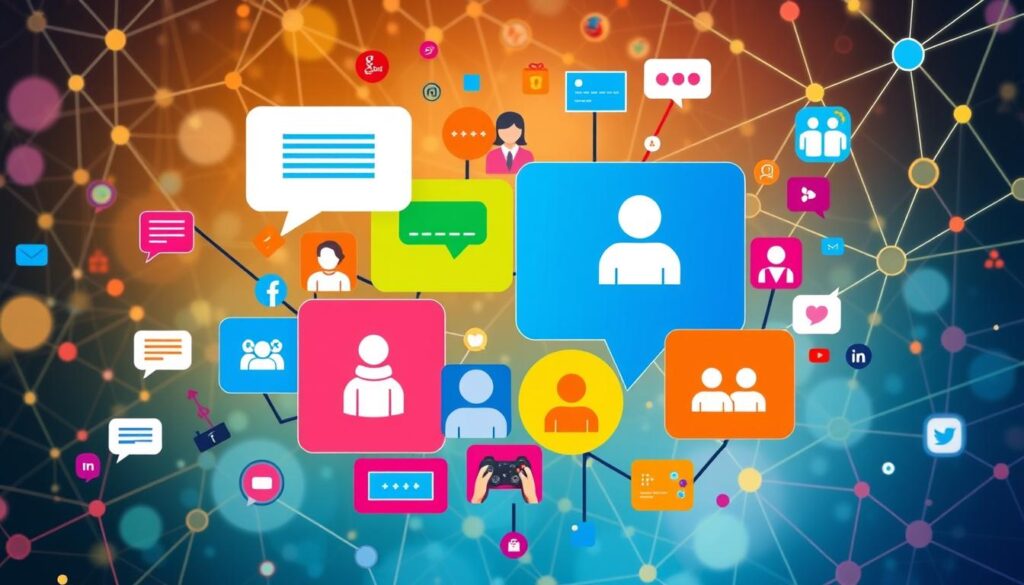“What Is e Community‘In today’s digital world, knowing about e communities is key for many. They are more than just online places. They are places of support, learning, and teamwork.
Network Kansas started the idea of e communities. They help connect business leaders, entrepreneurs, and local resources. Now, online communities are more than forums. They are places where people can really connect, no matter where they are.
Your online network can help you grow. If you run a startup, own a small business, or lead a community, e communities can help. They open doors to new chances for learning and success.
E-communities mix technology with people, making it easy to share knowledge and work together. They break down old barriers. Now, we can network, learn, and support each other online.
Looking into these digital spaces can change how we succeed together. E-communities help us share resources and form partnerships. They change how we grow and succeed in today’s digital world.
Understanding the Concept of e Community
Digital communities have changed how we connect and share online. They’ve grown from simple chat rooms to advanced platforms. These platforms connect people worldwide, creating real connections.

Online forums have changed a lot with new technology. Learning about digital communities can help you understand their parts and growth.
Defining Digital Communities in Modern Context
Digital communities are groups of people with shared interests and goals online. They offer:
- Real-time communication channels
- User-generated content spaces
- Collaborative engagement opportunities
- Specialized interaction environments
Key Components of Virtual Communities
Good digital communities have key parts that make them valuable:
| Component | Description |
|---|---|
| Shared Interests | Central theme connecting community members |
| Moderation | Maintaining healthy interactions and guidelines |
| User Participation | Active content creation and engagement |
Evolution of Online Community Platforms
Community platforms have evolved a lot. They now have features like multimedia sharing and mobile access. These platforms have changed how we interact online.
Being part of digital communities opens up new chances for networking and sharing knowledge. It connects people from all over the world in different fields.
Types of e Communities and Their Functions

Online communities have changed how we connect online. They bring people together with common interests and goals. These digital spaces offer unique chances for community engagement across different platforms and structures.
Different types of e communities serve different purposes. Each is designed to meet specific needs of its members:
- Professional Networks: For career growth and making industry connections
- Interest-Based Communities: For hobbies, passions, or expertise
- Support Groups: For emotional support and shared experiences
- Brand Communities: For connecting with product enthusiasts
Social networks are key in these digital spaces. They let members share knowledge, collaborate, and form meaningful relationships without limits.
Business-focused e communities, like the Greater Miami County Economic Development Corporation, show the benefits. These communities offer:
- Access to funding resources
- Technical training opportunities
- Networking platforms
- Professional development support
Research shows 77% of people visit online communities to find new insights. This highlights their growing role in our digital world. By understanding these diverse community types, you can use them for personal and professional growth.
The Role of e Communities in Business Development
Digital platforms are changing how entrepreneurs meet, work together, and grow their businesses. Online communities are now key places for innovation and support in many industries.
The modern business world is seeing fast growth in digital community involvement. Market research shows the power of online communities for business growth:
- The global community engagement platform market was valued at $526 million in 2021
- It’s expected to hit over $2 billion by 2030
- Now, 33% of companies have online communities with 10,000+ members
Supporting Entrepreneurship Through Online Networks
Entrepreneurs find big benefits in online communities. Sites like Upwork connect over 18 million freelancers with businesses. This shows how strong community building is in professional networks.
Community-Based Funding Initiatives
Digital platforms are changing how small businesses get funding. Peer-to-peer lending and crowdfunding are key for entrepreneurs looking for new funding options.
Business Resource Sharing and Collaboration
| Company | Community Size | Key Achievement |
|---|---|---|
| HP | 5.1 million members | 41% reduction in inquiry resolution time |
| Visa | 24,000 members | 124% increase in community membership |
| Zoom | 389,000 members | 186,000+ member posts |
By using online communities, businesses can share knowledge, work together, and find new solutions in many areas.
What Is e Community and Its Impact on Society
E-communities have changed how we connect and work together worldwide. These digital spaces help us interact without being in the same place. They open up new ways for us to join forces.
The effects of e-communities go beyond just talking to each other. They bring about big changes:
- Global connectivity that goes beyond physical limits
- More people can share information
- Decisions can be made faster and more together
- It’s easier to come together for social causes
Numbers show how powerful e-communities are. 82% of marketers say communities help keep customers. Companies that use online communities see big wins:
| Community Impact Metric | Percentage |
|---|---|
| Brand Loyalty Increase | 50% |
| Customer Support Ticket Reduction | 30% |
| Engagement Level Growth | 30% |
But, e-communities also have their downsides. Privacy, digital gaps, and fake news are issues. Knowing what e-communities are means seeing their good and bad sides.
The future of how we talk, learn, and work together will rely on these digital spaces. They keep changing how we connect and work together worldwide.
Building and Managing Digital Community Platforms
Creating successful digital community platforms needs careful planning and new tools. How you manage your community can greatly affect its success.
Digital community platforms have changed how we connect and work together online. With the right tools and plans, you can create lively, interactive communities. These communities offer real value to their members.
Essential Tools for Community Management
Choosing the right community management tools is key to success. Top platforms have features that make engagement easier:
- Mighty Networks: Ranked #1 online community platform with 99% customer satisfaction
- Circle: Offers pricing from $99 to $360 per month
- Discord: Free platform with strong communication tools
- Slack: Supports unlimited members with direct messaging
Creating Engagement Strategies
Good community engagement needs careful planning. Focus on:
- Understanding your audience’s demographics
- Creating content that targets your audience
- Encouraging people to get involved
- Using interactive features
Measuring Community Success
Keep track of your community’s success with important metrics:
| Metric Category | Key Performance Indicators |
|---|---|
| Marketing | Market share, customer sentiment, NPS |
| Customer Service | CSAT, response time, member retention |
| Product Management | Customer feedback, beta testing insights |
By using these tools and strategies, you can build thriving digital community platforms. These platforms can help create lasting connections and engagement.
Mobile Resources and Community Outreach
Digital platforms are changing how we connect and support each other. Mobile resources are key for reaching out beyond old online forums. Now, you can get help and find resources no matter where you are.
Mobile tech has changed how we help communities. Groups use apps and mobile sites to bring services right to people. This way, important help gets to those who need it fast and well.
- Real-time communication channels
- Location-based service delivery
- Personalized community support
- Instant access to community resources
The Community Lifelines project has been leading in mobile strategies since 2018. It showed great results during big events like hurricanes and the COVID-19 pandemic. Now, emergency teams are working to use mobile tech more in their work.
Local police are great examples of using mobile tech for outreach. Programs like Coffee with a Cop and Leadership Summer Camp show how mobile tech can help people and services talk better.
By using mobile resources, we can build stronger, more flexible support systems. These systems can meet the changing needs of our communities.
Membership Structure and Benefits in e Communities
Exploring e communities means understanding their membership structures. These structures are key to engagement and value. Choosing the right membership tier can greatly enhance your experience in social networks.
Community building relies on various membership options. These options meet different needs and expectations. Recent studies offer valuable insights into these dynamics:
- 82% of organizations offer multiple subscription options
- 67.3% of membership owners seek improved engagement strategies
- 57.10% maintain stable pricing to build member trust
Different Membership Tiers
Effective e communities offer flexible membership structures. These structures meet various user needs. Common tiers include:
| Membership Level | Annual Cost | Key Benefits |
|---|---|---|
| Basic | Free | Limited access, community forums |
| Professional | $250 | Advanced resources, networking events |
| Premium | $500 | Exclusive content, priority support |
Access to Community Resources
Your membership opens up a wealth of resources. Depending on your chosen tier, you get access to workshops, research, and webinars. These resources help you grow professionally.
Networking Opportunities
Social networks in e communities offer great connections. Premium memberships give you direct access to industry leaders. This can boost your career and personal growth.
By choosing the right membership tier, you’ll get the most out of your e community experience.
Educational and Empowerment Programs
Digital communities have changed how we learn and grow. They offer new ways to support each other through education and empowerment. These platforms give us the tools we need to improve ourselves and our careers.
Community involvement is key to these programs’ success. Groups like Explore Ecology teach over 38,000 kids about taking care of the environment every year. This shows how building a community can make a big difference by sharing knowledge.
- Skill development workshops
- Online training courses
- Mentorship opportunities
- Peer-to-peer learning networks
Helping entrepreneurs grow is at the heart of many programs. Kiva helps by giving small loans to entrepreneurs who need them. The Grameen Foundation also helps, teaching thousands of women new skills and giving them financial support.
| Program Type | Impact Metrics |
|---|---|
| Vocational Training | Supports economic independence |
| Leadership Development | Enables community decision-making |
| Entrepreneurship Support | Creates job opportunities |
By focusing on community, these programs tackle big social and economic issues. Every successful entrepreneur can help create jobs for five more people. This shows how education can have a big impact.
Conclusion
Exploring virtual communities shows how they’ve changed our world. They let us connect, learn, and interact in new ways. These digital spaces are key for bridging gaps and creating real connections.
Brands like Patagonia and Nike have shown the power of community. They use shared values and experiences to connect with people. This approach builds strong digital communities that foster loyalty and identity.
Virtual communities have the power to make a difference. They support learning and create opportunities. Whether it’s for community service or brand engagement, they’re changing how we connect and collaborate.
Looking to the future, e communities will likely use new tech like AI and VR. This will open up new ways to connect and share. By joining these digital platforms, you can be part of a global network that breaks down barriers and creates lasting connections.
